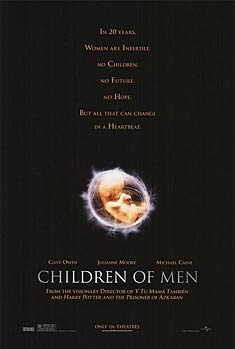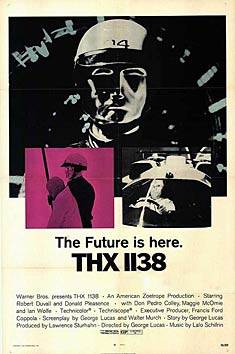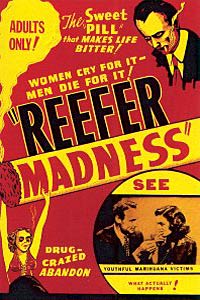They Call It Puppy Love
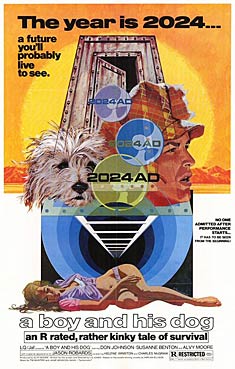 I’ve been feeling a little down lately.
I’ve been feeling a little down lately.
I attribute it to all this talk these days about the Mayan calendar and the Apocalypse. You know, end of the world, mass extinction, nuclear war. It’s a bit of a downer. I figured I would get some lighthearted video to lift my spirits.
Like something with a dog in it. Dogs always make me feel better.
So I’m at the library, vacillating between Turner & Hooch and Air Bud, when I see this film jacket with a young Don Johnson (that’s right – Nash Bridges himself) looking like some kind of train conductor. And he’s got a lovable, scruffy haired pooch.
The title said it all. A Boy and His Dog.
I say to myself, “For the love of Benji, that’s it! I’ll see this A Boy and His Dog movie. I like trains. I like dogs. This will make me feel better. It will make me forget about the whole end of the world Apocalypse thing.”
Then I get it home. Pop it in. And low and behold…
It’s about the freakin’ Apocalypse. Who knew? And no trains, either.
If you haven’t seen A Boy and His Dog, the premise is pretty simple. There’s a boy. He has a dog. They communicate telepathically and spend their days hunting for food and female companionship. Oh yeah, the world has been destroyed by nuclear war, and food and women are in exceedingly short supply.
The first half of the film follows The Don as he and his dog Blood lead a hard-scrabble existence among the burnouts and hippies of the wasteland. Kind of like a Burning Man event, except with fewer deaths, arrests and Land Management citations.
The Don’s job is to keep Blood fed. Supposedly Blood can no longer find food on his own, as some kind of tradeoff for telepathic powers. And Blood, in return, is charged with finding young women for The Don’s social calendar. Every time a young female is near, Blood’s mental sonar pings like he was straight out of Das Boot.
The Don and Blood are at a stag show in the middle of Nowheresville (this was a decade before Tina Turner built her Thunderdome and civilized the place), when Blood’s pinger starts pinging. That’s exciting news for The Don, who realizes he has an opportunity to make a new friend.
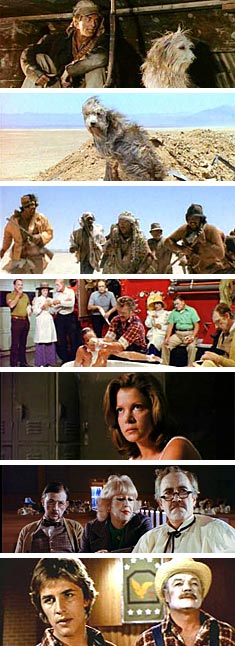 A new friend is right. She’s a beautiful young woman who, unknown to The Don, is actually bait planted by the weird people who live underground (I’ll get to that in a moment).
A new friend is right. She’s a beautiful young woman who, unknown to The Don, is actually bait planted by the weird people who live underground (I’ll get to that in a moment).
Well, some of the local burnout fellas also take a hankerin’ to the young lady, so The Don has to fight them off with his best Sergio Leone gunbattle. Of course he wins, because he’s The Don, and after some tender moments, the young lady makes her escape.
Well, of course The Don has to go after her. In this case, it means he has to follow her underground.
Blood, wounded during the gunbattle with the local fellas, protests The Don’s decision and stays topside.
This sets us up for a major transition. The film’s vibe at this point goes from “Grateful Dead” to “Dead Kennedys”.
The Don finds himself smack in the midst of a society of mimes and rodeo clowns. Led by the inestimable Jason Robards, everyone wears white face paint and rosy cheeks, and cottons to strange ideas about health care and polygamy.
They also have a lot of picnics, heavily featuring corn on the cob, which I found particularly fascinating.
Nothing says “Apocalypse” like corn on the cob. Except maybe canned tuna. And zombies. (But there’s no tuna or zombies in this movie, so corn it is.)
Jason Robards and his two cronies run the show in the underground city (one of the cronies is none other than the great Alvy Moore, who you may remember as “Hank Kimball” in Green Acres. Brilliant casting!).
To enforce their will on the populace, Robards and company employ a Nebraska linebacker named Michael who can crush a man’s skull. With his bare hands. Yowsers.
Now you may ask, with the mime makeup and corn on the cob, what makes these underground Midwesterners so hostile? Well, everyone has to wear overalls, for one thing. But also, they’re unable to reproduce. They must trap topsiders, such as The Don, and lure them underground to repopulate.
It’s not the glamour job you think it is. Trust me.
Think animal husbandry.
When you see it, you’ll know.
Obviously, this is not a good situation for The Don. He must escape. Being The Don, it’s time for more pistol work. This leads to the ending, which in my book is one of the most shocking and controversial of all time.
I won’t spoil it for you, other than to say it doesn’t involve corn on the cob.
If there is one lesson about the Apocalypse that I took away from A Boy and His Dog, it’s this: Pack lunch.
ONLY TWO WEEKS LEFT! – BATTLEFIELD EARTH CHARITY CHALLENGE!
Worlds Without End created a tribute fund through St. Jude Children’s Research Hospital –
Help us reach our charity goal. Make a donation, be my charity sponsor, and I promise I will sit through an entire viewing of Battlefield Earth, no matter how painful it gets.Come Aboard, We’re Expecting You
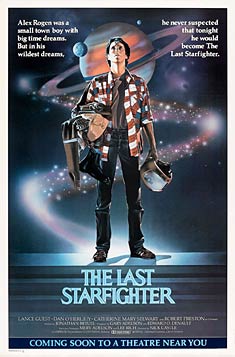 As military recruitment propaganda films go, I find The Last Starfighter to be something of an odd duck.
As military recruitment propaganda films go, I find The Last Starfighter to be something of an odd duck.
The Last Starfighter is ostensibly a mid-1980’s escapist entertainment about a trailer park kid who’s conscripted into some kind of galactic corps, thanks to his prowess at video games. But underneath, the film is something more nefarious – namely, yet another misguided government attempt to ramp up recruitment in lieu of mandating a draft, by making military service seem fun and adventurous.
Directed by Nick Castle, who co-wrote Escape From New York with John Carpenter, The Last Starfighter burst onto the scene in 1984 and if memory serves was largely embraced and cherished by the filmgoing populace.
Having seen the film last night, I’m left with one burning question. Why?
I went in with high hopes. Castle, after all, was the man responsible for much of the New York humor of Escape From New York, including the character of Cabbie. For my money, anyone who can shoehorn Ernest Borgnine into a John Carpenter film deserves an Oscar nod.
Our hero, Lance Guest, the trailer park kid with the hot hand, spends much of the film in a state of reluctance. I don’t really blame him. I spent much of this film in a state of reluctance, too.
Lance doesn’t embrace being the last starfighter because it’s dangerous, and he only agrees to take the helm after much cajoling from the supporting cast. Robert Preston never worked so hard. (It was a long time after The Music Man, but Bob still had the sparkle.) 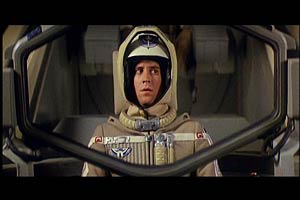
(SIDE NOTE: I spent a good deal of time worrying that I wouldn’t make it all the way through The Last Starfighter, which doesn’t bode well for my scheduled viewing of Battlefield Earth. I need your moral support. Please. The things I do for you people.)
Lance’s reluctance can be ultimately traced back to what I call “The Stubing Effect.” ™
The Stubing Effect refers to the fact that the Rylans (the good aliens Lance is conscripted to fight for) all look like Captain Stubing from The Love Boat.
Even the females.
When even the women in your film look like Captain Stubing from The Love Boat, you know you’re in trouble. Big trouble.
It’s the over indulgent use of Gavin MacLeod clones that I think is the downfall of this film. That, and the fact that the film is heavily laden with CGI. Now consider we’re talking 1984 CGI here. My Atari 2600 was pumping out better pixels than The Last Starfighter.
I could almost forgive the cheesy CGI. But the overuse of Stubing is too much.
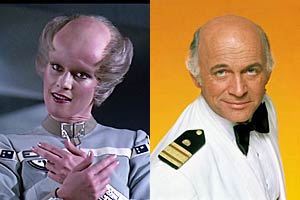 Now, I love Gavin MacLeod as much as the next person. I’m a big fan of The Gav. Big fan. But somehow His Stubingness just doesn’t translate well into science fiction.
Now, I love Gavin MacLeod as much as the next person. I’m a big fan of The Gav. Big fan. But somehow His Stubingness just doesn’t translate well into science fiction.
So I ask the United States Air Force (who undoubtedly was behind the making of this film), “As a recruitment film, do you really think female Stubings are the way to psychologically press gang young men into military service?”
Female aliens with male pattern baldness just don’t really impress me as a way to entice America’s youth to be all they can be.
Admittedly, I don’t remember much more from the film than that, reeling as I was from Stubingness. There was something called a Zando-Zan that looked like a crawfish taking potshots at Lance and his robot twin in a trailer park. And they finished the film with the dreaded Death Blossom starship attack. Beyond that, it’s a blur.
For my money, the better military recruitment film from 1984 was Red Dawn, featuring well-choreographed Patrick Swayze musical numbers. “Nobody puts Baby in a corner!” Now isn’t that exactly the go-get ’em attitude you want from your armed forces?
DON’T FORGET – BATTLEFIELD EARTH CHARITY CHALLENGE!
Worlds Without End created a tribute fund through St. Jude Children’s Research Hospital –
Help us reach our charity goal. Make a donation, be my charity sponsor, and I promise I will sit through an entire viewing of Battlefield Earth, no matter how painful it gets.The Curé of Mars
I had the happy occasion to watch a sad movie recently.
The sad movie was Alfonso Cuarón’s Children of Men, and to my mind it demonstrates the best that science fiction can be.
It’s a deeply felt movie, intense and raw, the way that Saving Private Ryan is deeply felt, intense and raw. I say it’s a sad movie, because of the world it portrays (and how close that world looks like ours), but ultimately the film’s message is one of hope.
If you’re not aware of Children of Men, the narrative is simple yet beautiful. It is the year 2027, and humanity has lost the ability to procreate. Mankind is slowly dying out. Into this cauldron of despondency, a miracle occurs – a pregnant woman (presumably the only such in the world) is discovered, and Theo Faron (played by Clive Owen) must shuttle her to safe refuge, with the hope being that scientists can learn from her how to jumpstart the human race.
There are many things to admire about this film. The realism and believability of the situation. The reliance on the genuine humanity of the characters to tell the story, rather than special effects and wild concepts. The subdued messaging backgrounded throughout the film which doesn’t draw attention to itself but adds necessary grit and political color.
I’m more than halfway through P. D. James’ book of the same name right now (the source material for the film), and it is remarkably different. The book is pastoral, academic, an epistle of despair in a decidedly English tone; the film on the other hand is ripe with street-level danger, violence, anger.
I could go on and on about the many things I love about Children of Men, enough to write a paper, but for the purpose of today I’m just going to touch ever so briefly on the character of Theo Faron.
Jonathan McDonald recently posted a link on Worlds Without End to an article by Robert R. Chase regarding the relationship between science and religion in science fiction. I found the synchronicity of this posting to be fortuitous, as Children of Men is at its heart a very religious movie. And Theo Faron, despite his jaded, secular posturing, is a decidedly religious figure.
In fact, I would go so far as to say he’s a saint. Let me explain.
In considering Theo’s transformation from cynical loner to true and loyal guide, you can’t but help see him as a post-modern St. Joseph. Protector of the mother and her child, he leads her to safety despite many obstacles, giving of himself totally to his mission. Theo’s story is a beautiful psalm of self-donation.
To my mind, it is unmistakable that Cuarón and his fellow screenwriters drew inspiration for Theo Faron from the life of St. Joseph.
This led me to consider just how freely science fiction films can dip into the lives of saints for inspiration. What follows is a brief exploration of ten saints and the film characters who echo them.
10 Lives of Saints Appropriated for Science Fiction
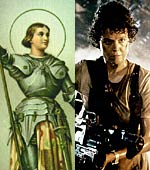 10. St. Joan of Arc – Joan’s life followed a dramatic path from a simple and seemingly inconsequential peasant to renowned warrior and leader who ultimately was burned alive for her faith.
10. St. Joan of Arc – Joan’s life followed a dramatic path from a simple and seemingly inconsequential peasant to renowned warrior and leader who ultimately was burned alive for her faith.
Cinema Equivalent: “Ellen Ripley” played by Sigourney Weaver / Alien3 (1992) – Ellen rises from a simple and seemingly inconsequential space trucker to become a leader of soldiers before being consumed by a fiery conflagration.
9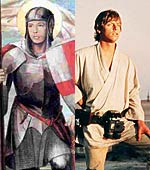 . St. George – A solider and priest, St. George is best known for his legendary exploit of vanquishing a dragon that dwelt in a lake and preyed upon a nearby town.
. St. George – A solider and priest, St. George is best known for his legendary exploit of vanquishing a dragon that dwelt in a lake and preyed upon a nearby town.
Cinema Equivalent: “Luke Skywalker” played by Mark Hamil / Star Wars: Return of the Jedi (1983) – A solider and priest, Luke counts among his most notable exploits the vanquishing of the Rancor Monster that dwelt in a pit in Jabba the Hutt’s lair.
 8. St. Francis of Assisi – A wild young man and one-time soldier who would undergo a conversion experience, renounce all he’d ever known to follow a simple life; a lover of nature, of the environment and of animals.
8. St. Francis of Assisi – A wild young man and one-time soldier who would undergo a conversion experience, renounce all he’d ever known to follow a simple life; a lover of nature, of the environment and of animals.
Cinema Equivalent: “Jake Sully” played by Sam Worthington / Avatar (2009) – A one-time soldier who would undergo a conversion experience, renounce all he’d ever known and discover an appreciation of nature, the environment and indigenous life.
 7. St. John the Baptist – During a period of struggle and conflict, he was a strong and courageous spiritual leader. St. John pointed the way for Jesus (the Messiah), whom he baptized in the Jordan River.
7. St. John the Baptist – During a period of struggle and conflict, he was a strong and courageous spiritual leader. St. John pointed the way for Jesus (the Messiah), whom he baptized in the Jordan River.
Cinema Equivalent: “Morpheus” played by Laurence Fishburne / The Matrix (1999) – During a period of struggle and conflict, he was a strong and courageous leader. Morpheus pointed the way for Neo (the One), whom he introduced to the world of the Matrix via the red pill of truth.
 6. St. Martin de Porres – The illegitimate son of a nobleman and a former slave, St. Maretin’s family upbringing consisted of his mother and younger sister. A strong student who outshone his teachers, he became a worker of healing miracles and champion of the poor and disenfranchised.
6. St. Martin de Porres – The illegitimate son of a nobleman and a former slave, St. Maretin’s family upbringing consisted of his mother and younger sister. A strong student who outshone his teachers, he became a worker of healing miracles and champion of the poor and disenfranchised.
Cinema Equivalent: “Paul Atreides” played by Kyle MacLachlan / Dune (1984) – The illegitimate son of a nobleman and his concubine, Paul’s family upbringing consisted of his mother and younger sister. A strong student who outshone his teachers, he became a worker of miracles and champion of the disenfranchised Fremen.
 5. St. Damien of Molokai – Working among the quarantined outcasts of the leper colony of Molokai, St. Damien eventually succumbed to leprosy contamination.
5. St. Damien of Molokai – Working among the quarantined outcasts of the leper colony of Molokai, St. Damien eventually succumbed to leprosy contamination.
Cinema Equivalent: “Wikus van de Merwe” played by Sharlto Copley / District 9 (2009) – Working among the quarantined outcasts of the alien colony of District 9, Wikus eventually succumbed to alien contamination.
 4. St. Barbara – Persecuted by her pagan father, who handed her over to the Roman authorities, St. Barbara refused to renounce her Christian affiliations.
4. St. Barbara – Persecuted by her pagan father, who handed her over to the Roman authorities, St. Barbara refused to renounce her Christian affiliations.
Cinema Equivalent: “Princess Leia” played by Carrie Fisher / Star Wars: A New Hope (1977) – Persecuted by her Sith father, who handed her over to the Imperial authorities, Princess Leia refused to renounce her rebel affiliations.
 3. St. John Vianney, the Curé of Ars – An undistinguished man whose superiors held low expectations, St. John Vianney was assigned to the small out-of-the-way parish town of Ars, which he proceeded to single-handedly clean up from its vice-ridden and morally lawless ways.
3. St. John Vianney, the Curé of Ars – An undistinguished man whose superiors held low expectations, St. John Vianney was assigned to the small out-of-the-way parish town of Ars, which he proceeded to single-handedly clean up from its vice-ridden and morally lawless ways.
Cinema Equivalent: “Marshall O’Niel” played by Sean Connery / Outland (1981) – An undistinguished man whose superiors held low expectations, Marshall O’Niel was assigned to the small out-of-the-way mining station on Io, which he proceeded to single-handedly clean up from its vice-ridden and morally lawless ways.
 2. St. Paul – The great evangelist and missionary of the Church, St. Paul travelled far to deliver the message to the people of this world to atone for our obsession with sin, or perish.
2. St. Paul – The great evangelist and missionary of the Church, St. Paul travelled far to deliver the message to the people of this world to atone for our obsession with sin, or perish.
Cinema Equivalent: “Klaatu” played by Michael Rennie / The Day the Earth Stood Still (1951) – A great missionary from the stars, Klaatu travelled far to deliver the message to the people of this world to atone for our obsession with nuclear weapons, or perish.
 1. St. Joseph – At first reluctant to get involved, St. Joseph agrees to protect and defend the Virgin Mary and her baby. They undertake an arduous journey, and while on the road the Virgin Mary gives birth to the miracle child who is the hope of humanity. Father, mother and infant then flee into Egypt to escape persecution.
1. St. Joseph – At first reluctant to get involved, St. Joseph agrees to protect and defend the Virgin Mary and her baby. They undertake an arduous journey, and while on the road the Virgin Mary gives birth to the miracle child who is the hope of humanity. Father, mother and infant then flee into Egypt to escape persecution.
Cinema Equivalent: “Theo Faron” played by Clive Owen / Children of Men (2006) – Theo, approached by his former lover (Julian) to help secretly transport a girl (Kee) across security-tight Britain, is at first reluctant to get involved. When he discovers Kee’s pregnancy, however, he agrees to protect and defend Kee and her baby. They undertake an arduous journey, and while on the road Kee gives birth to the miracle child who is the hope of humanity. Theo, Kee and her baby must then flee out of the Bexhill Refuge camp to the sea.
I can’t do Children of Men justice with a paltry blog, but I can say that as long as our filmmakers continue to bring us deeply felt stories such as this, I have no doubt that science fiction film has a bright future.
DON’T FORGET – BATTLEFIELD EARTH CHARITY CHALLENGE!
Worlds Without End created a tribute fund through St. Jude Children’s Research Hospital –
Help us reach our charity goal. Make a donation, be my charity sponsor, and I promise I will sit through an entire viewing of Battlefield Earth, no matter how painful it gets.Love is a Battlefield
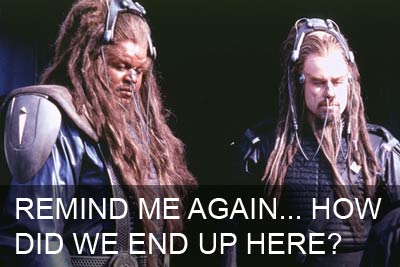 Should artists apologize for their work?
Should artists apologize for their work?
(No, I’m not gearing up to make amends for the poor quality of my blogs. Get over yourself.)
In considering artistic apologies, let’s review the recent hullabaloo regarding Battlefield Earth.
Within the last several weeks, it was reported that the screenwriter of Battlefield Earth (who shall remain nameless out of consideration for his well being), upon being notified that the film was chosen the worst of the decade by the Razzie Awards, issued an apology for its suckiness. I haven’t seen the film, but I’m going to go out on a limb and assume it’s pretty bad.
Noseplugs. Codpieces. Vinnie Barbarino. Scientology. Yeah, all that together is likely what I would classify as pretty bad.
Now, I question the screenwriter’s sincerity. First, he’s a writer, so he’s automatically suspect. But then, rather than take full ownership for his sins, he stepped over the line and pointed the finger at a second party.
In this case, the second party was the Scientologists. “They changed the entire tone. I knew these notes would kill the movie.”
Now, I’m not in the business of taking up for the Scientologists, but haven’t they been picked on enough? It’s not bad enough they almost got Tom Cruise kicked out of Germany. Or that a heavy rotation of enemas factor into their regimen. They have to take responsibility for producing Battlefield Earth, too?
C’mon, screenwriter guy. Own it. Well, in fairness, he did.
“Now, looking back at the movie with fresh eyes, I can’t help but be strangely proud of it. Because out of all the sucky movies, mine is the suckiest.”
Anyway, all this “worst movie of the decade” talk got to me thinking that we could use this opportunity somehow to raise money for a worthy cause. But how? Then it hit me.
For charity, I will sit through a complete viewing of Battlefield Earth and write about it.
I think I’m up for the challenge. After all, I suffered through both Pandorum and Cloverfield within the last week, which I figure is like going to training camp for slogging through a viewing of Battlefield Earth. How much worse can it be? (I’m afraid to find out.)
Regrettably, my local library (where I get all my free movies) didn’t have a copy of Battlefield Earth, so I had to go out and buy one (I really need to get on NetFlix).
Here’s the deal:
Worlds Without End has created a tribute fund through St. Jude Children’s Research Hospital. Your part is to go to the website and make a donation to the tribute fund. Big or small, they will take it all and put it to good use.
For my part, I will sit through Battlefield Earth at the end of May (tentatively May 27) and share the love in a future edition of Thies’ Pieces. Be my charity sponsor, and I promise I will sit through the entire film, no matter how painful it gets.
From St. Jude’s website:
St. Jude Hospital has become a world renowned research facility in the area of pediatric cancers such as leukemia. Children from all across the U.S. as well as 60 foreign countries have been admitted to St. Jude without regard for the family’s ability to pay.
St. Jude relies on the generosity of people like you to continue vital research and patient care programs, which are saving many young lives. Because of this support, St. Jude has seen the survival rate for Acute Lymphoblastic Leukemia (ALL), the most common form of leukemia, increase from 4% in 1962 to 94% today.
Help us out and let’s raise a nice sum for St. Jude and the families they assist.
Juke Box Hero

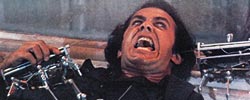
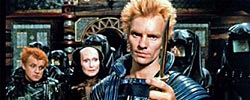
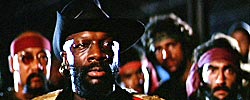
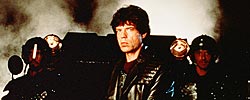
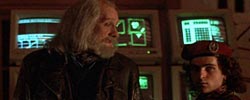
You may remember that a few weeks back I examined the influence of Kim Milford and Laserblast, science fiction’s version of Reefer Madness.
This week, we’re going to consider a different kind of reefer madness: namely, the use of pop musicians as actors in science fiction films.
Milford’s star-crossed career (one-time lead singer of the Jeff Beck Group, as well as front man for Moon, a 1970s rock outfit) got me to wondering: What other ill-advised cross-pollinations have taken place between popular music and science fiction film?
I’m not sure what’s the deal, but for some reason it seems that directors like to cast rock ‘n’ rollers in science fiction films. And I don’t just mean cameos, which in themselves are frankly pretty annoying.
(Aren’t cameos just a distraction that says, “Hey, don’t forget you’re only watching a movie and here’s a famous person we roped in to pull you out of the story!” As if someone – i.e. the director – was trying to leverage his way into a Hollywood party via stunt casting. Either that or it’s a goofy studio trick to get butts in seats.)
We decided to poll our readers to see what you think. So here we are, with a quest to discover the 10 most unnecessary rock ‘n’ roll crossovers into science fiction.
Here’s the skinny. Listed below are the names of popular musicians and the films they’ve appeared in. Rather than give you our top 10, we figured we’d give you a list and you can decide for yourself which are the 10 that were the most unnecessary.
We limited our list to actual roles. Meaning no cameos, which generally range from the silly (Huey Lewis in Back to the Future) to the pointless (Ministry in A.I.). We also didn’t include any actors who later tried and failed to become popular musicians (so no, Spock Sings and Keanu’s Dogstar didn’t qualify their thespians for the list).
Also, if we missed any candidates, feel free to add ‘em to your list.
So here are the good, the bad, and the ridiculous. Happy voting.
From the list below, choose your top ten most unnecessary rock ‘n’ roll crossovers into science fiction:
- Adam Ant / Cyber Bandits (1995)
- Annette Funicello / Dr. Goldfoot and the Bikini Machine (1965)
- Annette Funicello / The Monkey’s Uncle (1965)
- Billy Idol / Heavy Metal 2000 (2000)
- Common / Terminator Salvation (2009)
- David Bowie / The Man Who Fell to Earth (1976)
- David Johansen / Freejack (1992)
- Debbie Harry / Videodrome (1983)
- Dweezil Zappa / The Running Man (1987)
- Flea / Back to the Future II (1989)
- Flea / Back to the Future III (1990)
- Frankie Avalon / Dr. Goldfoot and the Bikini Machine (1965)
- Frankie Avalon / Voyage to the Bottom of the Sea (1961)
- Gene Simmons / Runaway (1984)
- Grace Jones / Cyber Bandits (1995)
- Harry Connick Jr. / Independence Day (1996)
- Harry Connick Jr. / The Iron Giant (1999)
- Henry Rollins / Johnny Mnemonic (1995)
- Huey Lewis / Sphere (1998)
- Ian Dury / Judge Dredd (1995)
- Ice Cube / Ghosts of Mars (2001)
- Ice-T / Johnny Mnemonic (1995)
- Ice-T / Tank Girl (1995)
- Iggy Pop / Hardware (1990)
- Iggy Pop / Tank Girl (1995)
- Isaac Hayes / Dream Warrior (2003)
- Isaac Hayes / Escape From New York (1981)
- Isaac Hayes / Oblivion (1994)
- Isaac Hayes / Oblivion 2: Backlash (1996)
- Jamie Foxx / Stealth (2005)
- Janet Jackson / The Nutty Professor 2: The Klumps (2000)
- Jennifer Lopez / The Cell (2000)
- Jerry Garcia / Heartbeeps (1981)
- Kris Kristofferson / Millenium (1989)
- Kris Kristofferson / Planet of the Apes (2001)
- LL Cool J / Deep Blue Sea (1999)
- LL Cool J / Rollerball (2002)
- Ludacris / Gamer (2009)
- Mark Wahlberg / The Happening (2008)
- Mark Wahlberg / Planet of the Apes (2001)
- Martin Kemp / Cyber Bandits (1995)
- Michael Des Barre / Nightflyers (1987)
- Mick Fleetwood / The Running Man (1987)
- Mick Jagger / Freejack (1992)
- Mos Def / The Hitchhiker’s Guide to the Galaxy (2005)
- Pat Boone / Journey to the Center of the Earth (1959)
- Queen Latifah / Sphere (1998)
- Ruben Blades / Predator 2 (1990)
- RZA / Repo Men (2010)
- Sting / The Bride (1985)
- Sting / Dune (1984)
- Tiffany / Jetsons: The Movie (1990)
- Tina Turner / Mad Max Beyond Thunderdome (1985)
- Toni Basil / Village of the Giants (1965)
- Tricky / The Fifth Element (1997)
- Tyrese Gibson / Death Race (2008)
- Tyrese Gibson / Transformers (2007)
- Tyrese Gibson / Transformers: Revenge of the Fallen (2009)
- Vanity / Neon City (1991)
- Will I Am / X-Men Origins: Wolverine (2009)
- Will Smith / I Am Legend (2007)
- Will Smith / I, Robot (2004)
- Will Smith / Independence Day (1996)
- Will Smith / Men in Black (1997)
- Will Smith / Men in Black II (2002)
- Will Smith / Wild Wild West (1999)
- Willie Nelson / Starlight (1996)
- Xzibit / The X Files: I Want to Believe (2008)
Waiting for the Man
Now I don’t intend to get overly political here. But let’s face it.
Government-run healthcare is one of the “big ideas” frequently explored in science fiction.
With sci fi films often functioning as social commentators, the idea of Big Health has been played out many times before. One of the more fascinating of these Cassandras was George Lucas’s THX 1138. It has all the elements.
Big Government. White pajamas. Severe haircuts. Compulsory drug addiction. Poor décor choices.
Though we’re never certain where THX 1138 takes place, we can deduce that it’s either a dystopia or EDS.
THX 1138 features Bob Duvall in a bravura performance as THX, a Boo Radley getting his “Billy Corgan” on. Coincidentally named after the license plate number on my dad’s puke green Chevy Nova, Bob holds down a gig at Chernobyl, building the android Erik Estradabots™ that provide security for the dystopia (or EDS).
Given the dangerous and mind-numbing rigors of his employ, Bob needs to be dosed on heavy narcotics to be able to function at his job (it must be EDS). To make matters worse, sex is against the law, everyone’s hopped up on libido limpers and, completing the narrative crucible, Bob shares an apartment with a comely young woman named LUH (played by Maggie McOmie).
It doesn’t take long before LUH and Bob decide that things might heat up if they go cold turkey. (Note to self: when you find you’re constantly apologizing to your medicine cabinet, it’s time to call Betty Ford.) Taking Nancy Reagan’s advice to just say no, our young couple discovers that life really is more fun without clothes. For awhile, things are peaches and cream.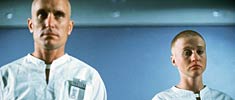
But without his prescriptions, Bob finds it that much harder to work at Chernobyl. Compounding matters, enter creepy stalker Donald Pleasence (this was 10 years before Pleasence entered politics, got elected President and subsequently crashed into the New York Maximum Security Penitentiary).
Donald, as LUH’s boss, sabotages Bob and LUH’s sexcapades by assigning LUH to the nightshift. The creep factor is that Donald did it because he wants to take LUH’s place as Bob’s roommate. Yikes! What’s up with that, George Lucas? Keep this guy out of men’s rooms in Idaho, for pete’s sake!
 It doesn’t take long for Bob and LUH to get busted for evading their healthcare obligations. Bob is briefly thrown in prison with LUH and they commence to, er, you know, but they are cracked down in mid-canoodle by the Estradabots. Bob is re-located to an area with other male prisoners, including the Donald. (Yikes! Can I get away from this guy?)
It doesn’t take long for Bob and LUH to get busted for evading their healthcare obligations. Bob is briefly thrown in prison with LUH and they commence to, er, you know, but they are cracked down in mid-canoodle by the Estradabots. Bob is re-located to an area with other male prisoners, including the Donald. (Yikes! Can I get away from this guy?)
Sparing you the details, Bob makes an escape with the Donald and another guy. Chased by the Estradabots through the streets of EDS, they are split up. The Donald attacks a priest and then later is apprehended talking with kids. Goodbye, Uncle Ernie!
Bob and the other guy, doing their best Defiant Ones impression, sneak into EDS’ IT server room, where Bob discovers that LUH has been permanently outsourced. Busting loose, our boys carjack a couple of Mach 5s and make a break for it, Estradabots in hot pursuit.
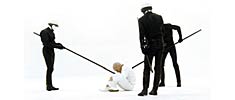 Though the other guy crashes his car, Bob reaches the EDS city limits and clambers up a ladder to freedom. EDS determines it’s spent too much already for Bob’s apprehension, and the Estradabots are ordered off the case. Bob emerges at the top of the ladder, resume in hand, sober, lonely and gainfully unemployed.
Though the other guy crashes his car, Bob reaches the EDS city limits and clambers up a ladder to freedom. EDS determines it’s spent too much already for Bob’s apprehension, and the Estradabots are ordered off the case. Bob emerges at the top of the ladder, resume in hand, sober, lonely and gainfully unemployed.
For their part, the Estradabots would re-emerge as Max Von Sydow’s hockey squad in Strange Brew, thanks to their dexterous stickwork.
With all the recent hullabaloo surrounding healthcare, it seemed timely to remind our loyal readers of this film.
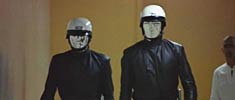 From Brave New World to Logan’s Run, and on and on, the idea that your medical requirements are best serviced by the government is an idea that has gained a lot of imaginative speculation over time.
From Brave New World to Logan’s Run, and on and on, the idea that your medical requirements are best serviced by the government is an idea that has gained a lot of imaginative speculation over time.
Politically speaking, I suppose the antithesis of big government health care would be mega-corporate private healthcare. But with films like Repo Men and Resident Evil, science fiction shows us that you essentially get the same result: a paucity of genuine human compassion that would make even Blue Cross/Blue Shield cringe.
The moral of today’s column?
 If someone wants to size you for government-issued pajamas, run!
If someone wants to size you for government-issued pajamas, run!
Watching THX 1138, I found it particularly chilling when one of the Estradabots said to our man Bob, “Everything will be all right. You are in my hands. I am here to protect you. You have nowhere to go. You have nowhere to go”.
I’m not entirely sure, but I think Nancy Pelosi said the same thing on the House floor.
Laser Madness
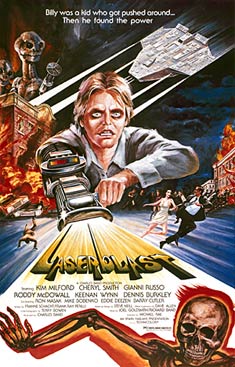 I’m not much of a film critic.
I’m not much of a film critic.
I can admit it. The reason I can admit it is that I know I just don’t have the heart to slam a movie just because it’s a bad movie.
For me, “bad” is not enough of a qualifier to unleash on a film. Picking on a bad movie is like kicking a guy when he’s down. They’ve suffered enough. I’d rather save the sarcasm for the movies (and filmmakers) who are wildly successful. They can take it.
Having tried my hand at screenwriting (and having no luck at it), I learned to respect the process. I’ve been there. The shameless hawking of a story idea to anyone who’d listen. The rewrites of rewrites. Query letters. Trying to get an agent. Plowing through screenwriting books. All that.
If nothing else, the experience taught me that if a person actually does get a story turned into a movie, that’s really something. It’s a lot of work, and you really have to care strongly about what you’re doing if you even want a shot at seeing it through.
To sell a screenplay is a big deal. To see it then turned into a movie is a huge deal.
I firmly believe no one ever sets out to write a bad movie.
Because of this, I give “bad” movies slack. I try to look beyond their faults and weigh what their creators were trying to do or say.
All this is lead up for today’s review of what has been universally reviled as one of the worst movies of all time. The 1978 science fiction opus known as Laserblast.
For those of you unfamiliar with the film, it relates the tale of Billy, whom we are to understand is a much put-upon teenager, and the aftermath of his discovery of an extraterrestrial weapon of mass destruction. We follow Billy as he goes on a rampage against those who torment him, before finally descending into madness, mutation and eventual death at the hands of the aliens who return to Earth to reclaim the weapon.
Having watched it last night, my head is still awash in its non sequitur narrative and undisciplined editing. Admittedly, the movie almost begs to be mocked. The dialogue. The acting. The effects, which fail one of the fundamental rules of science fiction cinema, a little something I call “The Krofft Rule.”
Essentially the rule states that your special effects m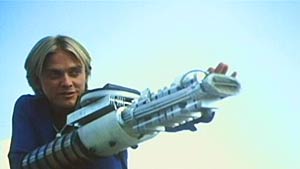 ust be measurably better than something that Sid and Marty Krofft manufactured during their TV entertainment heyday. If you’re rolling out a full-fledged film and you can’t outshine the Krofts’ “Grumpy the Tyrannosaurus,” you’re in big trouble.
ust be measurably better than something that Sid and Marty Krofft manufactured during their TV entertainment heyday. If you’re rolling out a full-fledged film and you can’t outshine the Krofts’ “Grumpy the Tyrannosaurus,” you’re in big trouble.
I knew Grumpy. Grumpy was a friend of mine. And Laserblast, you’re no Grumpy.
Laserblast featured (“starred” is too strong a word choice) Kim Milford as Billy. For you Jeff Beck freaks out there, Kim sang lead vocals for the Jeff Beck Group for roughly two weeks during the summer of 1972. (You would have to be a pathological Jeff Beck fan to know that, which I’m not.)
Milford would find more rewarding work as the villain opposite Mark Hamill (aka Luke Skywalker) in one of cinema’s greatest triumphs of the late 1970s.
I’m talking, of course, about Corvette Summer.
Anyway, in Laserblast we follow Milford as he becomes a deranged mutant killer blasting cars, people and domiciles with the laser weapon that happenstance has placed in his care.
Rather than get hung up on its shortcomings, I spent some time reflecting on Laserblast and the message that its filmmakers might have been trying to tell us.
I think I’ve found something.
Laserblast is noteworthy in its nihilism in that the hero is also the villain. There is no real foil to Billy, until the very end when the aliens blast the rampaging youth in an act of supernatural justice.
As an audience, we are confused as to who we’re supposed to root for. Rather, we watch helplessly as our hero self-destructs. The fact that we don’t really care because the film is so bad is beside the point. This led me to surmise that Laserblast is actually a sort of cautionary tale. If it’s a cautionary tale, what are we being cautioned against?
Laserblast is the Reefer Madness of the space era.
Eureka! Of course. The parallels are obvious.
In Reefer Madness, troubled youth of the 1930s taste forbidden fruits, go insane and dead end in a fatal crime spree.
In Laserblast, troubled youth of the 1970s taste forbidden fruits, go insane and dead end in a fatal crime spree.
Looking at Laserblast from this angle, you can deduce deeper meanings behind the deaths of Billy’s victims. Also telling is who among the film’s cast survives Billy’s rampage.
In essence, almost no figure with real authority dies in the film. Not Billy’s absentee mother, who makes a brief cameo before jetting off to Acapulco. Not the mysterious government agent. Not Billy’s girlfriend’s grandfather, the Colonel. Not the hapless town sheriff.
The deaths are relegated to the two bumpkin deputies, two bullies (the most unlikely bullies you will ever meet – remember Mandark from Dexter’s Laboratory?), and Roddy McDowell.
(McDowell, who plays a doctor in the film and hence an authority figure, wasn’t supposed to die in the original script, but he begged to be off’d after he realized what the film was going to do to his career.)
So, no one of significant authority is killed. And in fact, it’s telling that the two bumpkin deputies are seen smoking a doobie early in the film, a precursor to later onscreen fatality if ever there was one.
Like Reefer Madness, Laserblast was intentionally mad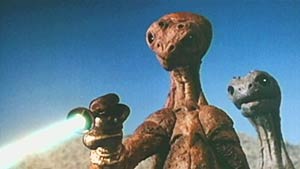 e to demonstrate the inherent dangers of a forbidden fruit and to scare kids away from it.
e to demonstrate the inherent dangers of a forbidden fruit and to scare kids away from it.
In Laserblast’s case, that forbidden fruit was alien technology.
What it all boils down to is this. A government plot to keep us from using alien weapons of mass destruction.
Think I’m kidding?
Listen, in the late 70s we were still getting our outer space on. Shuttles, Voyager satellites, stuff like that. Who knew what kind of stuff we’d shake lose from the stars. You poke a finger at the stars, they might poke back.
Remember the times in which Laserblast was made. The year before, Richard Dreyfuss was making mashed potato sculptures and getting unexplained suntans.
The government had to hedge their bets. They had to spread the word.
If you find something that looks outer-spacey, don’t touch it! You could end up like Billy!
That’s right. Laserblast was a government propaganda film. How else could it have been so bad?
Long, Long Way From Home
 Maybe it’s just me.
Maybe it’s just me.
Maybe I just have kooky associations that run through my head. I don’t know.
But, for some reason, whenever I listen to Foreigner, I think of Close Encounters of the Third Kind. Particularly Feels Like the First Time.
Okay, yes, I know, I just admitted to listening to Foreigner. Since I’ve already established that I like science fiction, it’s safe to assume I’m a bit socially awkward. The “Foreigner” confession just seals the deal. I still managed to move out, get married and have four kids. So there.
But truth be told, Feels Like the First Time harkens me back to 1977, when both Foreigner and Close Encounters arrived from some far distant place and emblazoned themselves on the world consciousness in an array of light and sound. (Actually, Foreigner formed in New York, but that’s a pretty alien place in its own right. And don’t aliens technically qualify as “foreigners”?)
Sitting here, listening to the amorous musical odyssey of Lou Gramm and his perm, I find myself waxing philosophical about Mr. Holland’s other Opus, Close Encounters. It had going for it the three things every American filmgoer was clamoring for in the Me Decade: Aliens! Outer space! François Truffaut!
So, the question dogging me is this: What happened when Roy Neary came home?
You know, I had never really considered the ramifications of his departure until I watched Spielberg discussing the film on a documentary. In that, he famously said that if he made Close Encounters now, as a father, he wouldn’t have had Roy leave Earth and his family behind.
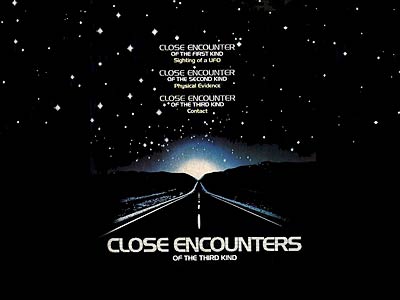 It’s an emotionally rich situation, and one that I hadn’t really considered before. I suspect that, like most audience members of the time, I didn’t factor that. I mean, c’mon, I was eight years old. I wanted Roy to take the ride.
It’s an emotionally rich situation, and one that I hadn’t really considered before. I suspect that, like most audience members of the time, I didn’t factor that. I mean, c’mon, I was eight years old. I wanted Roy to take the ride.
These days, with a family of my own, I’d be fascinated to see how the drama would play out if Roy returned.
Picture a kind of “Next Encounters of the Third Kind.” Here we are, 33 years later, and erstwhile Muncie electrician Roy Neary turns up to close the loop with the people he left all those years before.
His long-suffering wife Ronnie and their kids Brad, Sylvia and Toby, all now older than their father was when he left.
Can you imagine the emotional baggage being carried around by that group?
When the Neary clan last saw Dad, his passion for experimental gardening had gotten the better of him. Mom trundled the kids into the Vista Cruiser in a mad dash to get away from the old man for the safety of grandma’s. But at some point, they would have to return – and they would never know what became of their father.
Perhaps the government would feed them a line about how he perished in the toxic nerve gas spill in Wyoming. Perhaps not. Perhaps the family would simply think Dad flipped his cracker and disappeared forever. There’s a lot of unresolved pain there that we, as an audience, are oblivious to. But if we project forward along the narrative lines of those characters lives, we can certainly imagine the difficulties left behind in the wake of Roy’s decision to hitch a ride. I think it’s been said by others that Close Encounters of the Third Kind serves as a parable for divorce in the 1970s. That seems right to me.
So imagine Roy showing up now. Let’s say for argument’s sake he gets dropped off in a low-key affair. No government agents. No Devil’s Tower. No witnesses.
What kind of reception would he get when he found his way back to his family? Could he even find them? How could he explain himself to his wife and to his kids? How could he prove his story?
What if Ronnie was remarried?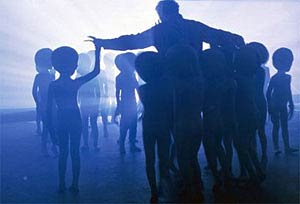 And what about Brad’s, Sylvia’s and Toby’s spouses and their kids? How would all those people deal with Roy’s re-entry?
And what about Brad’s, Sylvia’s and Toby’s spouses and their kids? How would all those people deal with Roy’s re-entry?
And what about Roy’s somewhat-surrogate family, Jillian and Barry Guiler? What is his emotional responsibility, if any, to them? You would assume that, having shared the monumental emotional experience that an alien close encounter would conceivably entail, they would have some kind of bond that would necessitate Roy bringing some closure to them as well.
Further complicating matters, how would Roy’s wife Ronnie feel about Jillian? Would she be jealous? We can presume that Roy’s kids wouldn’t have strong feelings about Barry, being they would likely be overwhelmed with issues about their long-lost absentee father, but what if Roy and the now-adult Barry shared the bond of their abductions? Would Roy’s kids understand why Dad seemed to favor this stranger?
And what about Roy himself? What kind of emotional turmoil would he be dealing with?
Conversely, what if Roy returned with the aliens in a grandiose, media-saturated manner? Everyone in the world hangs on his every word as Roy relates his experience on CNN. But what do his wife and kids think of the man who left them behind so he could boldly go where no Neary had gone before?
There would be a myriad of emotional dramas and issues to be dealt with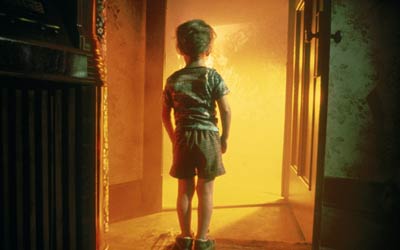 by the Nearys and the Guilers, regardless of the manner of Roy’s return.
by the Nearys and the Guilers, regardless of the manner of Roy’s return.
Admittedly, these are interior dramas and not the stuff of massive CGI budgets, but I think for me this is the kind of stuff that is important for science fiction, nonetheless. It’s what makes it real.
They say you can’t go home again. But I think it would be neat to try.
Wash. Rinse. Defeat.
Like most geeks, I am pretty amped up about the impending Tron sequel, Tron Legacy (yes, I know that I just used this space last week to rail against sequels and remakes; sue me – you think I get paid for this stuff?). Like most geeks, I have watched the trailer several times. And like most geeks, the trailer has left me with a burning question.
Namely, what’s with the albino guy?
If you haven’t seen the trailer, there is a fleeting glimpse of an albino doing an air guitar thing with a cane. A brief look at the blogosphere shows that this is a question that has lit a fire under Geek Nation.
Most bloggers I’ve seen are speculating that it’s either David Bowie or Jim Carrey (or both). However, the intrepid investigative journalists here at Worlds Without End have discovered that the albino is actually one of the Winter Brothers (we’re not sure which one, but my money’s on Edgar).
In honor of the serious hairdo sported by the presumed cyber-baddie, the WWE staff reached out to the American Society of Beauticians to help us create a list of the Top 10 Best Villainous Hairdos in Science Fiction. What follows is the result of months of furious polling by beauticians, barbers and hair aficionados from around the country.
Top 10 Best Villainous Hairdos in Science Fiction
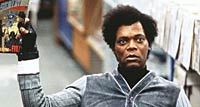 10. Elijah Price (played by Samuel L. Jackson) / Unbreakable (2000) – The man who originally spelled out for audiences that a big head is a hallmark for the bad guy. “Jules” popped the ‘fro ala Sly & The Family Stone style, knowing that it would eventually all get shaved off before he tackled the mother-f’ing snakes on the mother-f’ing plane.
10. Elijah Price (played by Samuel L. Jackson) / Unbreakable (2000) – The man who originally spelled out for audiences that a big head is a hallmark for the bad guy. “Jules” popped the ‘fro ala Sly & The Family Stone style, knowing that it would eventually all get shaved off before he tackled the mother-f’ing snakes on the mother-f’ing plane.
Did You Know?: His contract stipulates he must be given the coolest character name in any movie in which he is to appear.
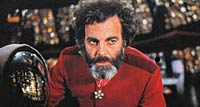 9. Dr. Hans Reinhardt (played by Maximilian Schell) / The Black Hole (1979) – Abandoned space craft. Black hole. Wild-eyed Bee Gee. Hello, can anyone say mad scientist? And what was up with Tony Perkins’ creepy mancrush? Gang, anyone named Dr. Hans on an abandoned space craft is NOT to be trusted.
9. Dr. Hans Reinhardt (played by Maximilian Schell) / The Black Hole (1979) – Abandoned space craft. Black hole. Wild-eyed Bee Gee. Hello, can anyone say mad scientist? And what was up with Tony Perkins’ creepy mancrush? Gang, anyone named Dr. Hans on an abandoned space craft is NOT to be trusted.
Did You Know?: He lost the part of Dr. Hans Zarkov in Flash Gordon to Topol, who was willing to do nudity.
 8. Benson (played by Harvey Keitel) / Saturn 3 (1980) – At first glance, the hair doesn’t seem like much, but flip up the bad midlife crisis ponytail, and you have a rocking Black and Decker brainjack that would prefigure the Wachowskis by two decades. Trend setter!
8. Benson (played by Harvey Keitel) / Saturn 3 (1980) – At first glance, the hair doesn’t seem like much, but flip up the bad midlife crisis ponytail, and you have a rocking Black and Decker brainjack that would prefigure the Wachowskis by two decades. Trend setter!
Did You Know?: Benson found new life in a spinoff series, starring Robert Guillaume, spending seven seasons in ABC’s prime time line-up.
 7. The Predator (played by Kevin Peter Hall) / Predator (1987) – Fan of corn rows ever since seeing Bo Derek in “10.” After his cameo role in Blake Edwards’ planned sequel “11” was scrapped, he went on a murderous rampage in South America, helping Jesse Ventura find time to bleed.
7. The Predator (played by Kevin Peter Hall) / Predator (1987) – Fan of corn rows ever since seeing Bo Derek in “10.” After his cameo role in Blake Edwards’ planned sequel “11” was scrapped, he went on a murderous rampage in South America, helping Jesse Ventura find time to bleed.
Did You Know?: He was a Colgate toothpaste model in the early 1970s.
 6. Chet Donnelly (played by Bill Paxton) / Weird Science (1985) – In what still stands as one of the wonders of pre-CGI Hollywood, wunderkind director John Hughes managed to realistically coif Rodney Dangerfield’s prostate. And Chet had the nerve to ask Vasquez if she’d ever been mistaken for a man?
6. Chet Donnelly (played by Bill Paxton) / Weird Science (1985) – In what still stands as one of the wonders of pre-CGI Hollywood, wunderkind director John Hughes managed to realistically coif Rodney Dangerfield’s prostate. And Chet had the nerve to ask Vasquez if she’d ever been mistaken for a man?
Did You Know?: He successfully ran Al Franken’s senatorial campaign in Minnesota.
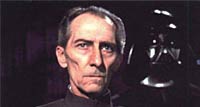 5. Grand Moff Tarkin (played by Peter Cushing) / Star Wars (1977) – Who else but a Hammer vet could take grandma’s hairdo and infuse it with such menace? Was it just me, or did Princess Leia actually flee into the arms of Darth Vader to get away from Granny Cushing? Really? Darth Vader? Like he’s going to protect you? Well, he was your father.
5. Grand Moff Tarkin (played by Peter Cushing) / Star Wars (1977) – Who else but a Hammer vet could take grandma’s hairdo and infuse it with such menace? Was it just me, or did Princess Leia actually flee into the arms of Darth Vader to get away from Granny Cushing? Really? Darth Vader? Like he’s going to protect you? Well, he was your father.
Did You Know?: He lent his hair to Jeff Conway for the 1978 film production of Grease.
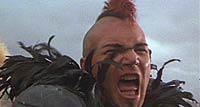 4. Wez (played by Vernon Wells) / The Road Warrior (1981) – Back when Mel Gibson traffic problems were a good thing, Wez epitomized the cliché that real men don’t ask for directions. This snarling ball of contempt for roadside assistance would later go quasi-gay as a henchman in Schwarzenegger’s Commando. Do you really want this guy going commando?
4. Wez (played by Vernon Wells) / The Road Warrior (1981) – Back when Mel Gibson traffic problems were a good thing, Wez epitomized the cliché that real men don’t ask for directions. This snarling ball of contempt for roadside assistance would later go quasi-gay as a henchman in Schwarzenegger’s Commando. Do you really want this guy going commando?
Did You Know?: He would later play tight end in the too-short lived XFL.
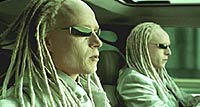 3. The Twins (played by Neil & Adrian Rayment) / The Matrix Reloaded (2003) – Eschewing their status as 70’s rock legends, Edgar and Johnny Winter tapped their inner Bo Dereks and dialed up some serious ghost ninja juju. Wardrobe by Mark Shale.
3. The Twins (played by Neil & Adrian Rayment) / The Matrix Reloaded (2003) – Eschewing their status as 70’s rock legends, Edgar and Johnny Winter tapped their inner Bo Dereks and dialed up some serious ghost ninja juju. Wardrobe by Mark Shale.
Did You Know?: They piloted The Suite Life of Marilyn Manson for the Disney Channel.
 2. Davy Jones (played by Bill Nighy) / Pirates of the Caribbean: Dead Man’s Chest (2006) – As Red Lobster’s spokesperson, he consummated the long-frustrated marriage of sex appeal and crab bisque. Plus, he gets bonus points due to the fact that his hairdo is prehensile.
2. Davy Jones (played by Bill Nighy) / Pirates of the Caribbean: Dead Man’s Chest (2006) – As Red Lobster’s spokesperson, he consummated the long-frustrated marriage of sex appeal and crab bisque. Plus, he gets bonus points due to the fact that his hairdo is prehensile.
Did You Know?: He co-starred in a revival of Goodbye, Mr. Chips.
And number one?
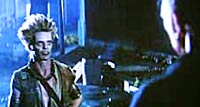 1. Romero (played by Frank Doubleday) / Escape From New York (1981) – Robert Pattinson, take note: this is unwashed hair that’s actually cool. With his prance, hyena laugh and octogenarian lingerie, Romero was “Cyndi Lauper” before being “Cyndi Lauper” was cool. “If you touch me, he dies. If you’re not in the air in 30 seconds, he dies.” He’s so unusual!
1. Romero (played by Frank Doubleday) / Escape From New York (1981) – Robert Pattinson, take note: this is unwashed hair that’s actually cool. With his prance, hyena laugh and octogenarian lingerie, Romero was “Cyndi Lauper” before being “Cyndi Lauper” was cool. “If you touch me, he dies. If you’re not in the air in 30 seconds, he dies.” He’s so unusual!
Did You Know?: He was the face of Jhirmack 1983.
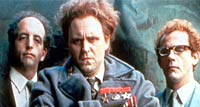 BONUS PICK! Dr. Emilio Lizardo / Lord John Whorfin (played by John Lithgow) / The Adventures of Buckaroo Banzai Across the 8th Dimension (1984) – Split personality meets split ends. Didn’t make the list proper because we couldn’t decide which one of him deserved the credit. The best villain in a Peter Weller film not to later star in That 70’s Show.
BONUS PICK! Dr. Emilio Lizardo / Lord John Whorfin (played by John Lithgow) / The Adventures of Buckaroo Banzai Across the 8th Dimension (1984) – Split personality meets split ends. Didn’t make the list proper because we couldn’t decide which one of him deserved the credit. The best villain in a Peter Weller film not to later star in That 70’s Show.
Did You Know?: He writes children’s books.
If you don’t agree with the results of this poll, please consult your beautician.
A Word of Warning

Let’s start off by coming clean on something that Hollywood already knows and we ourselves are loath to admit.
We, the audience, are a bunch of tramps. (And that’s putting it mildly.)
While our trampiness can be attributed to our willingness to financially support all manner of speculative dreck, for the purpose of today’s rant, I will focus my remarks on the oft-bemoaned phenomena of remakes and sequels that Hollywood seems hellbent on pushing down our all-too-willing throats.
Like the flood of remakes and sequels themselves, blogs complaining about Hollywood’s penchant for wholesale recycling of films are all-invasive. I recognize that I’m simply adding to the noise with one more blog, but if Hollywood continues to foist recycled films upon us, then we have the right to foist right back. So thank you very much.
Don’t get me wrong. I understand the business proposition here. Hollywood dumps in obscene amounts of money to make a film – any film – so you have to show a decent return on investment. It makes sense to go with a property that already has demonstrated it has legs in the marketplace, with built-in brand recognition and a ready-made fanbase. It makes good business sense.
But doesn’t that kind of suck?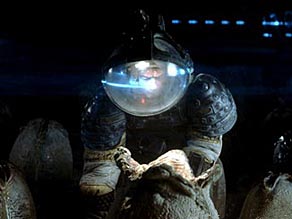
Hollywood has been at its best (see 1970s) when it at least had the pretense that it was putting its artists and their ideas above the desire for shareholder appeasement. There are still instances even in today’s film market where it feels that a certain film was made despite gross commercial considerations, but that’s happening with greater and greater infrequency.
Is it just me, or does it seem that every science fiction film made in the 1970’s and 1980’s is destined for the remake treatment? Just ask John Carpenter. I suspect there are probably a few TV commercials he made in-between films in the late 70’s that are probably being remade as I type this. Home movies. Maybe even a Polaroid or two. He’s the hardest working, not working director in Hollywood today. Seriously. Can They Live … Again be too far behind?
Let’s qualify “remake” and “sequel” – most of the time, they mean one and the same thing. A true sequel is the continuation of an ongoing story. For instance, Two Towers is a sequel to The Fellowship of the Ring. A sequel is something that is a necessary part in order to complete the story.
By comparison, Aliens (grand as it was) is really just a remake of Alien. I’m nuts, I know, but think about it. Alien was a self-contained story. You didn’t really need to know more than what it provided to you. And it’s the Alien franchise that I want to pick on today.
You should know that Alien counts as my favorite film of all time. Period. For a number of reasons that I’ll save for some other time when I don’t have anything else to blog about.
As far as I can tell, I’m the only person who wishes they stopped after the first movie.
That’s right – I’m saying it. I wish Aliens had never been made.
Yes, Jim Cameron is great. Aliens was great. Hudson was great. Guns. One liners. Newt. “Why don’t you put her in charge?” Burke wearing a suit with the collar up – great. Half of Lance Henrikson sloshing around in a pool of milk – well, yeah, pretty great, too. “Get away from her you bitch.” Alien Queen – dorky, but what the heck, two hours in, I’ll buy it.
 But when I read posts where people say it was actually better than the first film, I’m like, what the heck are you talking about? It was fun, but really the Alien universe was not improved with the advent of Aliens, Alien3 or Alien Resurrection. C’mon.
But when I read posts where people say it was actually better than the first film, I’m like, what the heck are you talking about? It was fun, but really the Alien universe was not improved with the advent of Aliens, Alien3 or Alien Resurrection. C’mon.
Alien. It was a punk rock shockwave across the sci fi spectrum at a time when Lucas was reintroducing Flash Gordon and Spielberg had us reaching for our xylophones to call the mothership. Alien was a seismic tremor that shook loose the Planet of the Apes-Logan’s Run-Omega Man doldrums of the 70’s and heralded something far more dangerous. Instead of Bruce Dern singing along to Joan Baez while growing intergalactic carrots on his way to Saturn, we got Parker going mano-a-mano with a headless robot aggressively trying to get Sigourney to renew her magazine subscription. Alien showed us that space is truly, deeply, really, in a word, alien. The creature had no eyes! Its tongue had teeth! And it had no respect for personal boundaries! Plus, H.R. Giger has this art school Peter Lorre vibe about him. Doesn’t all that just creep you out? Alien fulfilled its mission to tell you that the universe is a wild, weird place.
But, we’re tramps. We can’t let it alone. We want more. And we’ll pony up for it.
They had to make a sequel. They knew we would come. And we did.
Aliens was a huge hit. Bigger than the first one. So they kept going, milking the franchise and running it into the ground. Christopher Nolan was right – for the most part, the third film in any series sucks. In this case, so did the fourth film. Alien was weird in a genuine and pure way. So they kept going for it, but they manufactured the weirdness in subsequent films.
Alien felt like a punk rock anthem born in a garage. The others were studio films.
So now, we come to the Alien Prequel, coming to a theatre near you in 2011. Even without knowing anything of the story, it’s got a lot going for it. Ridley Scott, for one. Do you need more than that? Probably not, but it also has going for it that it escapes from all the narrative handcuffs placed on the franchise, thanks to films two, three and four. It’s a fresh start. A reboot, a … oh well, let’s just say it, a remake. Yeah, it is. So what?
The “so what” is that you have to ask yourself if there are any sacred cows left out in the sci fi pasture. Part of the beauty of Alien is that so much was left unexplained. Like Jaws (of which Alien has so oft been compared), you had to fill in the blanks for much of the movie. But what’s more, Alien was just weird from the get-go and didn’t really clear things up. Which is greatness. There was the derelict ship with Dumbo’s weird uncle fossilized in the pilot seat. Where did he come from? We might never know. And that is great. Where did the aliens come from? Who knows? Somewhere alien and weird. Great. Don’t shade it all in for me. Let me always wonder about that.
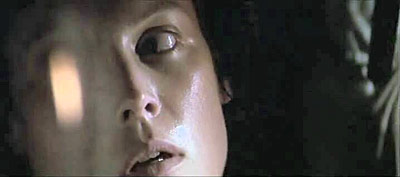 But Hollywood can’t let it go. And we can’t let it go. I tell you, when I heard that Ridley Scott was doing the prequel, I was gleeful. Gleeful, like a mad little kid. Still am. But now on reflection, I’m sad, too. Sad because I’d always hoped that some of the beauty would go unexplained and we’d always hang on to some of the mystery. Undoubtedly, the prequel will give us insight on where the aliens come from, why they are how they are, maybe even tell us more about Dumbo’s weird uncle. All that. And I can understand why Ridley Scott would want to restore the legacy of what was perhaps his greatest film by rescuing a franchise that has fallen into science fiction’s version of pro wrestling, a la the Alien versus Predator nonsense.
But Hollywood can’t let it go. And we can’t let it go. I tell you, when I heard that Ridley Scott was doing the prequel, I was gleeful. Gleeful, like a mad little kid. Still am. But now on reflection, I’m sad, too. Sad because I’d always hoped that some of the beauty would go unexplained and we’d always hang on to some of the mystery. Undoubtedly, the prequel will give us insight on where the aliens come from, why they are how they are, maybe even tell us more about Dumbo’s weird uncle. All that. And I can understand why Ridley Scott would want to restore the legacy of what was perhaps his greatest film by rescuing a franchise that has fallen into science fiction’s version of pro wrestling, a la the Alien versus Predator nonsense.
I wish I could tell you that I will stand strong. I won’t pay to go see the Alien Prequel. I will safeguard the mystery of the unexplained, of the pristine beauty of the long unknowable. But I know better. Once it’s out there, I will want to see it, too. Saying “don’t look at that thing” only makes you want to look at it the more. I just hope it’s good. Damn you, Hollywood. You know me too well.



















 Full Details
Full Details
